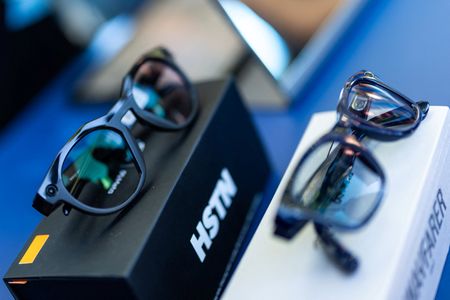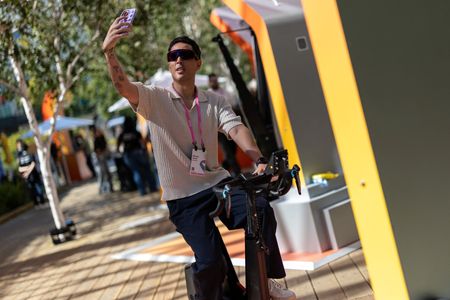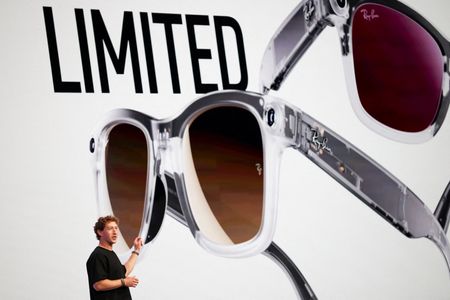By Aditya Soni and Echo Wang
MENLO PARK, California (Reuters) – Meta Platforms on Wednesday launched its first consumer-ready smart glasses with a built-in display, seeking to extend the momentum of its Ray-Ban line, one of the early consumer hits of the artificial intelligence era.
CEO Mark Zuckerberg showed off what he called Meta Ray-Ban Display, although some demos of the new technology did not go as planned, with a call to the glasses failing to go through, for instance.
“I don’t know what to tell you guys,” Zuckerberg said. “I keep on messing this up.” The crowd applauded.
Meta has tasted success with its smart glasses, and Zuckerberg described them as the perfect way to expand toward the ‘superintelligence’ promised by artificial intelligence, a concept where AI surpasses human intelligence in every possible way.
“Glasses are the ideal form factor for personal superintelligence, because they let you stay present in the moment while getting access to all of these AI capabilities that make you smarter, help you communicate better, improve your memory, improve your senses, and more,” Zuckerberg said.
The new Display glasses have a small digital display in the right lens for basic tasks such as notifications. They will start at $799 and be available on September 30 in stores.
The launch at Meta’s annual Connect conference for developers, held at its Menlo Park, California, headquarters, is its latest attempt to catch up in the high-stakes AI race.
While the social media giant has been at the forefront of developing smart glasses, it trails rivals such as OpenAI and Alphabet’s Google in rolling out advanced AI models.
Zuckerberg has kicked off a Silicon Valley talent war to poach engineers from rivals and promised to spend tens of billions of dollars on cutting-edge AI chips.
The new glasses come as Meta is facing scrutiny over its handling of child safety on its social media platforms.
Reuters reported in August that Meta chatbots engaged children in provocative conversations about sex and race, while whistleblowers said earlier this month that researchers were told not to study the harmful effects of virtual reality on children.
Meta also unveiled on Wednesday a new pair of Oakley-branded glasses called Vanguard aimed at athletes and priced at $499. The device integrates with fitness platforms such as Garmin and Strava to deliver real-time training stats and post-workout summaries and offers nine hours of battery life. It will be available starting on October 21.
It also updated its previous Ray-Ban line, which does not have a built-in display but now offers almost twice the battery life of the earlier generation and a better camera at $379, higher than the previous generation’s $299 price.
All the devices have existing features such as Meta’s AI assistant, cameras, hands-free control and livestreaming to the company’s social media platforms including Facebook and Instagram.
While analysts do not expect the Display glasses to post strong sales, they believe it could be a step toward the planned 2027 launch of Meta’s “Orion” glasses. Meta unveiled a prototype of that last year and Zuckerberg described it as “the time machine to the future.”
“It wasn’t long ago that consumers were introduced to AI on glasses and in recent quarters brands have also begun to include displays, enabling new use cases,” said Jitesh Ubrani, research manager for IDC’s Worldwide Mobile Device Trackers.
“However, consumer awareness and product availability of AI glasses with display remains limited. This will change as Meta, Google, and others launch products in the next 18 months.”
IDC forecasts worldwide shipments of augmented reality/ virtual reality headsets and display-less smart glasses will increase by 39.2% in 2025 to 14.3 million units, with Meta driving much of the growth thanks to demand for the Ray-Bans it makes with EssilorLuxottica.
(Reporting by Aditya Soni and Echo Wang in Menlo Park, California; Writing by Peter Henderson; Editing by Sayantani Ghosh and Matthew Lewis)














